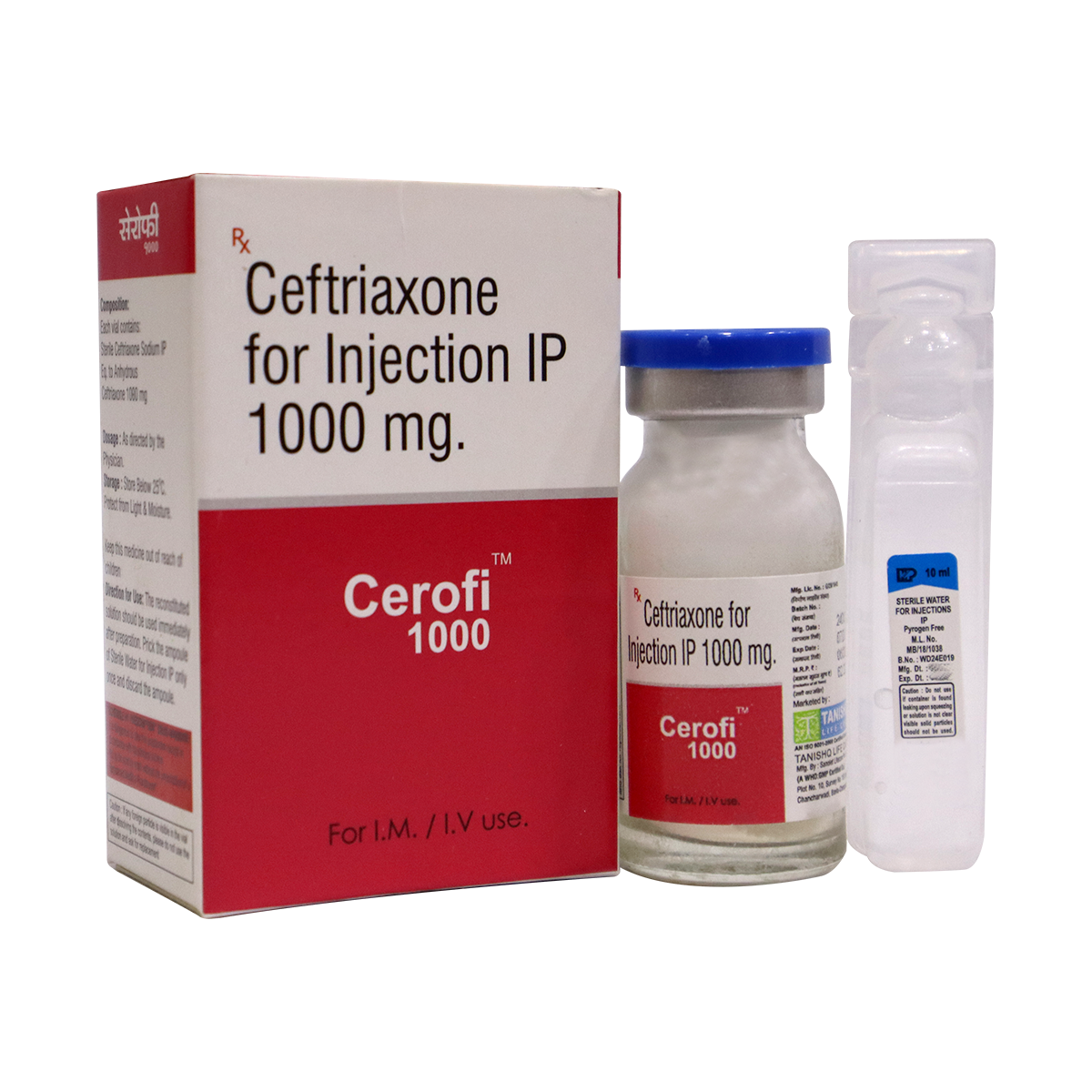
Cerofi-1000 Inj.
CEROFI-1000 is an injectable formulation containing Ceftriaxone, a broad-spectrum cephalosporin antibiotic. It is used for the treatment of various bacterial infections and is effective against both Gram-positive and Gram-negative organisms.
- Recommended Usage
Indications
- Bacterial Infections: Treats a wide range of bacterial infections, including:
- Respiratory Tract Infections (e.g., pneumonia, bronchitis)
- Urinary Tract Infections (e.g., cystitis, pyelonephritis)
- Skin and Soft Tissue Infections
- Intra-abdominal Infections (e.g., peritonitis, biliary infections)
- Meningitis
- Sepsis (bacterial bloodstream infections)
- Bone and Joint Infections
- Sexually Transmitted Diseases (e.g., gonorrhea)
- Preoperative Prophylaxis: Used to prevent infections in patients undergoing surgery, especially in high-risk procedures.
Dosage and Administration
Route of Administration: Intravenous (IV) or Intramuscular (IM) injection.
Typical Dose for Adults:
- General Infections: 1-2 grams once daily, or in divided doses every 12 hours, depending on the severity of the infection.
- Severe Infections: Up to 4 grams per day.
Dosage Adjustments: For patients with renal or hepatic impairment, the dose may need to be adjusted.
Administration: For IV administration, the drug should be reconstituted with an appropriate diluent (e.g., sterile water or saline). For IM administration, it is often mixed with a local anesthetic to reduce pain at the injection site.
Precautions
• Hypersensitivity: Avoid in patients with known hypersensitivity to ceftriaxone or other cephalosporins.
• Allergic Reactions: Discontinue the drug if signs of an allergic reaction (e.g., rash, anaphylaxis) occur.
• Renal and Hepatic Impairment: Use with caution in patients with impaired kidney or liver function; dose adjustments may be necessary.
• Neonates: Ceftriaxone should not be used in neonates who require calcium-containing solutions due to the risk of precipitation.
• Pregnancy and Breastfeeding: Use during pregnancy should be considered only if the benefits outweigh the risks. It passes into breast milk in small amounts and should be used cautiously while breastfeeding.
• Superinfection: Prolonged use may lead to superinfection with non-susceptible organisms, including fungi.
• Gastrointestinal Issues: May cause diarrhea, including Clostridium difficile-associated diarrhea.
Benefits
Broad-Spectrum Activity: Effective against a wide range of bacterial pathogens, both Gram-positive and Gram-negative bacteria.
Convenient Dosing: Once or twice daily dosing for many infections, simplifying the treatment regimen.
Effective for Severe Infections: Suitable for treating serious infections like sepsis, meningitis, and pneumonia.
Preoperative Prophylaxis: Reduces the risk of infections following surgery, particularly in high-risk cases.
Good Tissue Penetration: Ceftriaxone achieves good penetration into various tissues, including the lungs, brain, and bones, enhancing its effectiveness in treating deep infections.
Product Category
- Anti Infective
- Injectables
- Pre Filled Syringe
- Immunosuppressants
- Anti Ulcerant/ppis
- Joint Care
- Enzymes
- Heamatinic Agents
- Antioxidant Multivitamins
- Laxatives
- Anti Alergic
- Corticosteroids & Combinations
- Anti Fungal
- Medicated Soaps
- Emollients and Moisturisers
- Face Care
- Puva & Sun Protectors
- Hair Care
- Anti Acne Preparation
- Analgesics Antipyretics & Anti Inflammatory
- Anti Spasmodic & Anti Emetic
- Expectorants Antitussives & Mucolytics
- Antidiarrheals
- Cardiac Drugs
- Antipsychotics
- Anti Epileptics
- Migraine
- Anti Dyspetic
